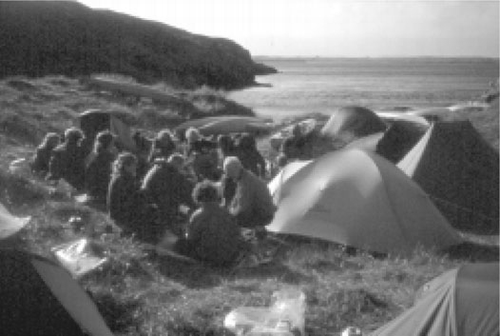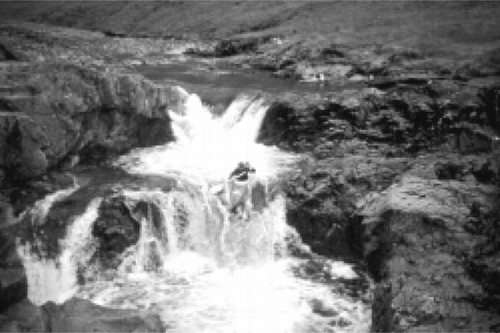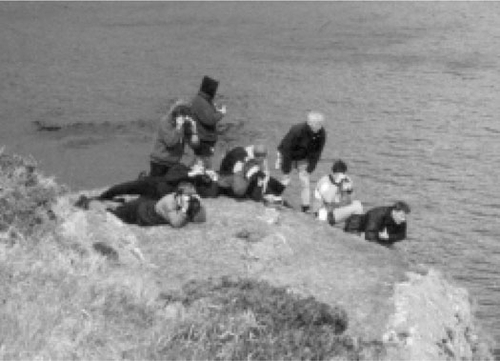Abstract
This article explores aspects of teacher education and outdoor education and their relationship with education for sustainable development (ESD) in Scotland. It considers recent developments in national education policy and the UNESCO (United Nations Educational, Scientific and Cultural Organisation) initiative to ‘re-orient teacher education towards sustainable futures’ with which the Faculty of Education of the University of Edinburgh is involved. The policy and practice of the faculty is discussed in relation to this national and international framework.
National Policy on Sustainable Development in Scotland
In July 1999, a Scottish Parliament convened in Edinburgh for the first time in almost 300 years. Whilst Scotland remains a part of the UK, a wide range of responsibilities and powers have been devolved to this parliament which include a number of policy areas central to ESD. These include environment, education, transport and health. However, some important policy areas such as energy and some fiscal measures are not devolved and this gives the parliament less room for manoeuvre.
As a signatory to Agenda 21, the UK government, and hence Scotland, is committed to its principles. These have been identified in Scotland through publications such as ‘Down to Earth: A Scottish Perspective on Sustainable Development’ (1999), which endorses the social, economic and educational aspects of sustainable development; and through the report of CitationThe Secretary of State for Scotland’s Advisory Group on Education for Sustainable Development (1999) which focuses specifically on education.
In February 2000, the Scottish Parliament passed a motion committing itself to placing sustainable development at the core of its work and in August 2000 the Scottish Minister for the Environment published a draft comprehensive environmental strategy. Although given credit by commentators for its attempt to open up discussion on sustainability issues, it was roundly criticised for a ‘business as usual’ approach and a lack of practical ideas. This is not to suggest that until now there has been no policy on sustainable development, rather that it has been piecemeal rather than integrated. Consequently, the general public has largely remained unaware of public policy in this area.
Structure of the Educational System at the National Level in Scotland
Whilst there is no national curriculum prescribed by statute, there is nevertheless is a national framework which is published by the Scottish Executive Education Department (SEED), which is universally acknowledged to constitute an appropriate curriculum (5–14 Guidelines) (CitationSEED, 2000). That curricular framework in the primary school covers language studies; mathematics; expressive arts; environmental studies; and religious and moral education. In the secondary school the curriculum framework covers language, mathematics, social studies, science, technology, physical education, and religious and moral education. These areas of study are not legally binding on schools: nevertheless, there is a strong professional consensus that these represent the major domains of human enquiry and reflection, into which all pupils as a matter of right, are entitled to be initiated.
Education and National Sustainable Development Policy
There is no explicit linkage between the educational system and the national sustainable development policy, and although in general terms the importance of education for the success of the policy is recognised, there is no mention of its role in the August 2000 draft environmental strategy. Although aspects of education for sustainable development are to be found in a number of places in curricular guidance in Scotland, these neither permeate the curriculum nor are they gathered together into a single integrated ESD theme. Although individuals in schools and higher education institutions are committed to ESD, the lack of policy direction leaves the area vulnerable.
Teacher education has no explicit recognition in the national sustainable development policy. However, in numerous policy statements the importance of education is fully acknowledged in enabling government policies to be realised.
The flexibility in the school curriculum noted earlier seems to be well suited to allow the inclusion of ESD. However, research on Scottish schools shows that subject boundaries are often tightly maintained, making any cross-curricular or permeation approaches likely to lead to only modest change (CitationNixon et al, 1999).
Teacher Education in Scotland
In Scotland teacher education is based in six centres, all of them with a considerable tradition of specialist work and all now formally part of universities as departments or faculties. Each centre offers a full range of training opportunities for work in primary schools and in secondary schools, although there are some areas of specialist provision (e.g. Physical Education) at just one or two centres.
All programmes of teacher education in Scotland have to comply with national guidelines issued from time to time by the Secretary of State/ First Minister, who is responsible to Scotland’s Parliament for the quality of education in Scotland. Also, they all require to be accredited by the General Teaching Council for Scotland. That body, which has as members the majority of practising teachers, has been the voice of the teaching profession in Scotland since 1965. It, in effect, controls entry to the teaching profession in Scotland.
While programmes must show compatibility with the national guidelines before they can be taught, there is scope for some variation between institutions on the nature of the curriculum they provide.
Structure of Teacher Certification
Teaching qualifications in Scotland are of three types: Teaching Qualification (Primary, Secondary, and Further Education). The national guidelines stipulate programme length and its general content. There are two routes into primary or secondary education:
A student may take a four-year degree leading to a Bachelor of Education (BEd) resulting in a qualification to teach in a primary or a secondary school (the concurrent route), or
First, complete a degree programme and subsequently take a one-year programme of professional education (a Postgraduate Certificate of Education - PGCE) (the consecutive route).
Whilst the former route has the advantage of specialist training in education, the structure severely limits the extent to which students can take programmes from other parts of their university. Those who take the consecutive route will have had ample opportunity to sample a range of university studies prior to their professional training, but this study is sharply focused.
Teacher Education Programmes and ESD
Whilst the structure of programmes is determined by the regulatory bodies, teacher education institutions can be as innovative and flexible as they wish, so long as their programmes are fully compatible with the national guidelines. Nonetheless, education for sustainable development does form part of the guidelines for teachers published by the Scottish Office Education and Industry Department (CitationSOEID, 1998). These include two specific references to teachers being knowledgeable about sustainable development and competent to contribute to ESD. Although Environmental Studies is one of the areas listed for study, this is an umbrella term for a range of subjects which are taught between the ages of 5 and 14 and which, in broad terms, deal with knowledge about the environment rather than ESD. ‘Education for Sustainable Development’ is listed as an option which teacher education institutions may make available. Therefore, it is left to the individual teacher education institutions to determine how much emphasis is to be given to ESD, either as a separate programme or as part of ‘Environmental Studies’.
Consequently, ESD components take different forms in different teacher education institutes. In some, there is a full programme of Education for Sustainable Development; in others this forms part of a wider programme of Environmental Studies.
National Developments in ESD
As a result of a national conference on the environment in teacher education in 1995, all teacher education institutions in Scotland committed themselves to the development of the BEd (Primary Education) module noted above. The application of the module and its key elements has been variable and whilst only one university (Strathclyde) has adopted the full module others have included relevant sections into their programmes whilst others have chosen a permeation model.
For some time in Scotland attempts have been made to mobilise professional support for ESD. Following the publication of the Learning for Life report (1996), whose major theme was sustainable development, a ‘Learning for Life Group’ was convened. This continues to meet regularly (2 or 3 times a year) and consists of representatives from all of Scotland’s teacher education institutions, together with representatives of a wide range of environmental agencies. The group recently prepared a document explaining the place of ESD in Scottish Teacher Education Institutions (available from the authors).
That group has developed resource materials for use in initial teacher education programmes, and has also developed a significant resource compilation for serving teachers. The Learning for Life Group was a key member of a group of institutions and individuals which the European Union funded to develop an in-service programme and materials for Sustainability Education in European Primary Schools (CitationSEEPS, 1997). This significant project and other resources produced are not binding on institutions. They were prepared as ways of fostering collaboration, of minimising the duplication of work at a time when resources are scarce, and as a way of stimulating teacher education centres to devote more time to ESD.
Teacher Education and ESD at the University of Edinburgh
At the University of Edinburgh the aspects of ESD noted above are included in the general training of teachers. However, there are several courses which have a particular emphasis. The BEd (Primary Education) includes a first-year residential fieldwork week with an ESD element and a further module in ESD at the end of the fourth year. Postgraduate (PGCE) students of geography have two fieldwork weekends with the emphasis as above, and an assessed part of their course which specifically addresses the role of geography in teaching for a sustainable future.
It is clear from the outline of teacher education in Scotland that room for manoeuvre is limited. However, within such constraints the Faculty of Education of the University of Edinburgh is now committed to a number of projects. For example:
In the BEd (Primary Education) the faculty will undertake an audit of the Environmental Studies course to see whether the ESD element can be enhanced. One current development is the inclusion of a course on ‘Technology and Sustainability’ within the Year 4 Option on Science.
The faculty website ‘Educating for a Sustainable Future’ (http://www.education.ed.ac.uk/esf) has been updated and further developed in a collaborative project with Manchester Metropolitan University.
Outdoor Education
Outdoor education has often been considered to be an approach to education which can permeate many curricular subject areas. Whilst outdoor activities are likely to dominate common perceptions, outdoor education is now seen within the profession as both an approach and a subject in its own right drawing on three integrated areas of outdoor activities, environmental education and personal and social development.
The themes of outdoor, adventure and education are all important in the process. An experiential approach to learning is a central tenet of outdoor education and in this context ‘adventure’ is seen as an approach to maximise the learning effect of the experience (CitationHiggins and Loynes, 1997). Scotland was one of the first places in the world where outdoor education became formalised and in the 1960s and ‘70s there was a significant focus on the environment (CitationHiggins, in press).
Outdoor Education and ESD
The natural environment is often considered in a utilitarian way as ‘the workplace’ for outdoor education ( to ). However, this perspective denies both the roots of outdoor education and a number of contemporary initiatives which emphasise the value of direct experiences of the natural heritage in education about the environment (field studies), fostering a ‘sense of place’ and in education for sustainable development (CitationCooper, 1991; Nicol and Higgins, 1998; and CitationHiggins, 1996). Central to this approach is the view that development of a relationship with the environment is an important precursor to understanding sustainability (e.g. CitationPalmer and Suggate, 1996).
University of Edinburgh and UNESCO
The 1992 United Nations Conference on Environment and Development (UNCED) held in Rio de Janeiro resulted in the agreement of participating nations (including the UK) on a number of environmental issues which all would address. A central commitment was the adoption of Agenda 21 (CitationUN, 1992), an action plan for progress. The importance of education to this plan is indicated in its presence as a theme in all chapters of the document, a chapter devoted to it (Chapter 36) and its frequency of use. In the document ‘education’ appeared only second in frequency to the word ‘government’ (CitationSmyth et al, 1997: 173).
Under Agenda 21 one of the four priorities identified was ‘Education, Public Awareness and Training for Sustainability’. As a result, UNESCO is addressing teacher education, which it sees as one of the most significant areas for action (CitationUNESCO, 1999). Hence, the task of ‘re-orienting teacher education to address sustainability’ is a direct result of decisions taken by governments at Rio.
Perhaps as a result of Scotland’s reputation for commitment to ESD, a representative of Moray House Institute (now the Faculty of Education) was invited to a UNESCO meeting in Thessaloniki in Greece in 1997 (CitationUNESCO, 1997). There were ten universities/teacher education institutes from around the world present at that preliminary meeting, and around 30 at the subsequent meeting in Toronto in 2000.
All participating institutions attending the Toronto conference agreed subsequent actions, the principles of which are described by CitationHopkins and McKeown (2001). Whilst each institution is free to decide on its own actions, there is a commitment to short-and long-term objectives of the UNESCO project. The Short Term objective is ‘to undertake research and experimentation on different approaches to re-orienting teacher education towards sustainability, using a common research framework to allow comparison of results’. The Long Term objective is ‘to develop suggestions and guidelines for re-orienting teacher education and associated realms of pedagogy, curriculum and evaluation’.
Broadly speaking, the University of Edinburgh commitment is to review the status of ESD in provision for teacher education and outdoor education. Some detail of the actions taken has been provided earlier in this paper. Attempts continue to raise the profile of ESD at university and national level. For further details see CitationHiggins et al (2001).
Concluding Comments
The inter-institutional collaboration between teacher education institutes and the environmental agencies noted earlier which led to the establishment of the ‘Learning for Life Group’ has led to a number of national and international initiatives at both pre-service and in-service levels. Successful bids have been made to Scottish and European funding agencies to develop resources to support initial teacher education programmes and programmes of continuing professional development for teachers in the field of ESD.
However, a teacher education curriculum which is ‘full’ already, and weak political commitment at a national level mitigate against a decisive advance of ESD in Scottish education. Although the fact that education follows national guidelines rather than a syllabus allows some room for manoeuvre, many requirements are stipulated and this makes extended provision in ESD difficult to achieve. Outdoor education, free from many of the curricular constraints provides one avenue for development, but it too lacks enthusiastic political (and hence financial) support.
There can be little doubt that ESD is finally moving up the political agenda in Scotland and must eventually become an imperative for the work of teacher education institutes. Some progress has been made though progress to date has depended primarily on individual and institutional commitment.
Websites
Faculty of Education, University of Edinburgh and Institute of Education, Manchester Metropolitan University: Educating for a Sustainable Future. This site is dedicated to providing on-line supported self-study materials for courses in Education for Sustainability in teacher education. The URL is: http://www.education.ed.ac.uk/esf
University of Edinburgh Outdoor Education Website: http://www.education.ed.ac.uk/outdoored)
References
- CooperG. (1991) The role of outdoor and field study centres in educating for the environment. Journal of Adventure Education and Outdoor Leadership, 8(2):10-11.
- HigginsP. (1996) Outdoor recreation: connection and consequence in outdoor education. Journal of Outdoor Education and Outdoor Leadership, 13(2): 34-39.
- HigginsP. (in press) Outdoor education in Scotland. Journal of Adventure Education and Outdoor Learning.
- HigginsP., KirkG. and PerfectH. (2001) Teacher education for sustainable development in Scotland. Environmental Education, 68: 25 - 29.
- HigginsP. and LoynesC. (1997) Towards consensus on the nature of outdoor education. Journal of Outdoor Education and Outdoor Leadership, 13(4): 2-3.
- Hopkins and McKeownC. (2001) Re-orienting teacher education to address sustainability. Environmental Education, 66: 8-9.
- NicolR. & HigginsP. (1998) A sense of place: a context for environmental outdoor education. In P.Higgins and B.Humberstone (eds) Celebrating Diversity: Learning by Sharing Cultural Differences, (pp.50-55). (Buckinghamshire: European Institute for Outdoor Adventure Education and Experiential Learning)
- NixonJ., SankeyK., FurayV. and SimmonsM. (1999) Education for sustainability in Scottish secondary schools: boundary maintenance or professional re-orientation? Environmental Education Research, 5 (3): 305-318.
- PalmerJ. and SuggateJ. (1996) Influences and experiences affecting pro-environmental behaviour of educators. Environmental Education Research 2(1): 109-121.
- Secretary of State for Scotland’s Advisory Group on Education for Sustainable Development (1999) Scotland the Sustainable. (Edinburgh: Scottish Office).
- SEED (2000) 5-14 Guidelines. (Dundee: Learning and Teaching Scotland and Edinburgh: Scottish Education and Employment Department.)
- SEEPS (1997) Sustainability Education in European Primary Schools: Creating a Better Environment in Our School. (Edinburgh: Moray House Institute of Education.)
- Scottish Office (1999) Down to Earth: A Scottish Perspective on Sustainable Development. (Edinburgh: Scottish Office)
- Scottish Office Education and Industry Department (1998) Guidelines for initial teacher education courses in Scotland. (Edinburgh: SOEID)
- SmythJ. (editor) (1993) Learning for Life: A National Strategy for Environmental Education in Scotland. John Smyth (Chairman). (Edinburgh: Scottish Office)
- SmythJ., BlackmoreC. and HarveyT. (1997) Education for sustainability at the United Nations: making progress? The Environmentalist, (17): 173-179.
- UNESCO (1997) Educating for a Sustainable Future: A Transdisciplinary Vision for Concerted Action. International Conference, Thessaloniki, December 1997. (Paris: UNESCO)
- UNESCO (1999) UNESCO and Education. (Paris: Documentation and Information Sector)
- UN (1992) Earth Summit 1992, the United Nations Conference on Environment and Development, Rio de Janeiro 1992. (London: United Nations, Regency Press Corporation)



